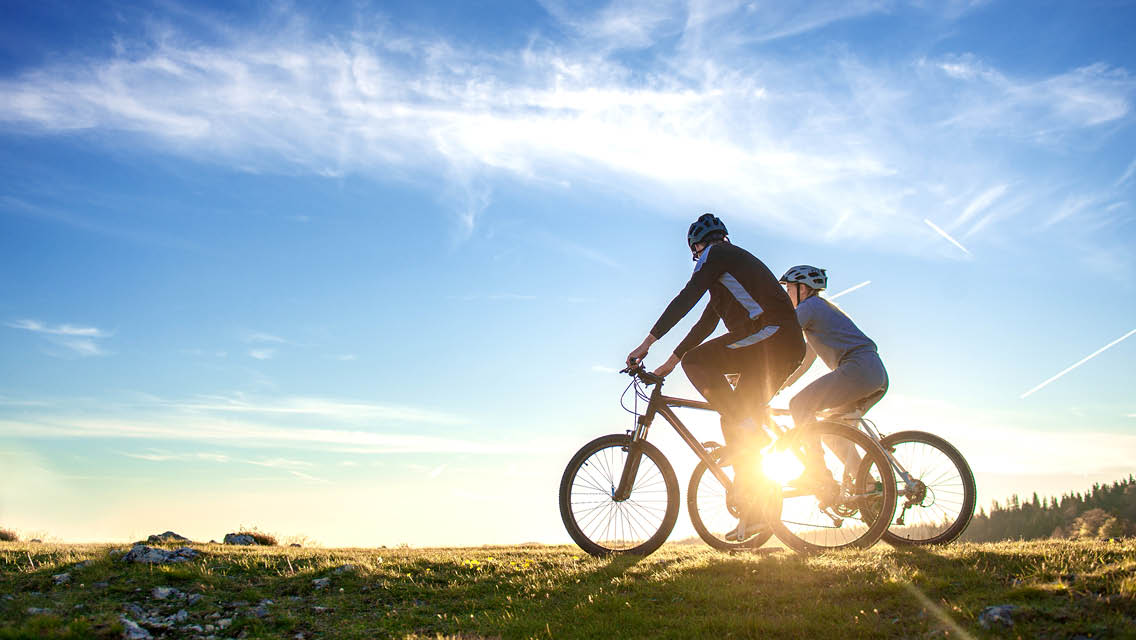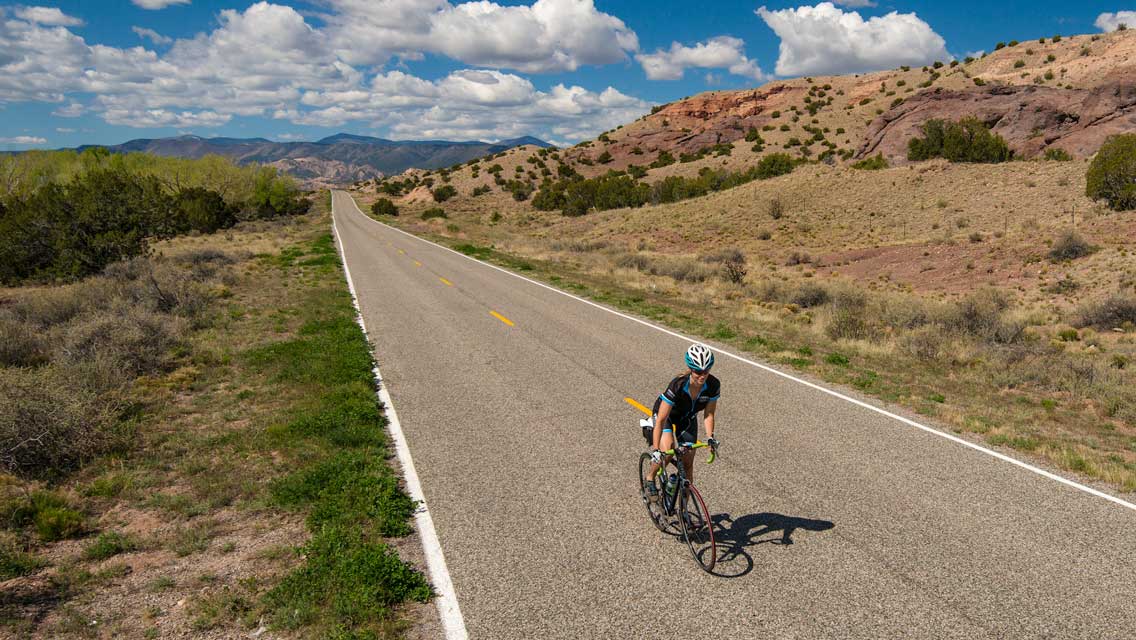“Life is like riding a bicycle. To keep your balance, you must keep moving.”
Those healthy-living words of wisdom come from none other than Albert Einstein. He was a cycling enthusiast of sorts; most of us have probably seen the photo of him riding a bicycle with a great big grin on his face. It’s widely believed that he conceived the theory of relativity while riding a bike.
One of the glories of bicycles, however, is that they’re not rocket science. In fact, they’re almost the opposite: simple, earthbound tools offering myriad wellness benefits. Here, we explore three key healthy aspects of cycling — all backed by research — plus offer a few insights from Einstein and other cycling aficionados.
1. Buff Up Your Physical Health
“Get a bicycle. You will not regret it, if you live.” So advised Mark Twain in the essay “Taming the Bicycle” (which he only just managed to do).
Bicycles were a relatively newfangled thing in the late 1800s, but people quickly hopped on. They enjoyed the speed and sense of freedom — and soon also realized the health benefits the two-wheelers delivered.
You need to keep moving not only to maintain your balance, as Einstein recommended, but to improve your health as well. Physical activity works like magic, yet it’s scientifically proven in study after study. Understanding the benefits of movement has become a huge area of research in recent decades, to the point where progressive healthcare providers are even prescribing activity.
And bicycling — along with walking, running, and swimming — is one of the simplest forms of movement. “It sounds trite, but the adage ‘It’s just like riding a bike’ exists for a reason: Cycling isn’t complicated,” says Life Time Academy master instructor Emily Booth. “The nature of cycling makes it uniquely accessible and effective for a wide variety of individuals. All you need to do is get on the bike and pedal.”
“Get a bicycle. You will not regret it, if you live.” – Mark Twain
“And with all of the innovation in bike technology, there are options for individuals of nearly every fitness level to engage in some form of cycling,” Booth explains. “There are traditional road bikes, mountain bikes, gravel bikes, commuter bikes, recumbents, adaptive bikes for those with disabilities, a variety of stationary bikes, and, most recently, e-bikes. Different pedal strokes for different folks!”
For such a simple activity, cycling is a boon for health, she adds — and other experts agree.
“Cycling 30 to 60 minutes per day has been linked with numerous health benefits,” explains Appalachian State University professor David C. Nieman, DrPH, FACSM, a pioneering researcher in exercise and nutrition immunology. He lists some of the key benefits of cycling:
- Fights chronic inflammation, which can play a role in conditions including heart disease, type 2 diabetes, stroke, cancer, and Alzheimer’s, as well as depression and other mental-health issues.
- Lowers all-around risk of hypertension, type 2 diabetes, and cardiovascular disease.
- Decreases risk of cancer, such as bladder, breast, colon, endometrial, esophageal, kidney, lung, and stomach cancer.
- Improves joint health, cardio function, and metabolism.
- Helps maintain weight by burning fat and by building lean muscle mass, particularly in the core and legs.
- Boosts mobility and all-around physical function while also reducing the risk of falls and related injuries, which is especially important for older adults.
- Enhances sleep quality.
- Lowers all-cause premature mortality.
A study published in the BMJ in 2017 found that regular cycling cut the risk of death from all causes by more than 40 percent, lowered the risk of cancer by 45 percent, and reduced the risk of heart disease by 46 percent among 263,450 study participants. (For more on the many benefits of activity, see “Made to Move“.)
Other forms of exercise are also beneficial, though, so what is it about cycling that makes it such a health promoter?
One of the key factors is that the bicycle — and not your hips, knees, or feet — bears most of your weight as you move. And because your legs work in a single plane, those joints also experience less lateral stress.
Plus, cycling is often considered a “life sport”: You can experience its benefits over the long term because there’s less wear and tear on the body.
In one study, Nieman compared cyclists and runners during a three-day period of intense training and found that cyclists experienced substantially less muscle damage, muscle soreness, and systemic inflammation for the same amount of effort. “Cycling is easy on the muscles,” he explains. Cyclists can put in longer workouts “and won’t feel as sore the next day.”
As for Twain’s “if you live” quip, bicycling — especially commuting — can indeed be dangerous. But that threat is far outweighed by the health benefits.
A 2018 study found that bicycle commuters are exposed to fewer toxic air pollutants compared with car drivers, who tend to sit in traffic longer. In regard to the potential for accidents, a study published in the BMJ in 2020 involving 230,390 British commuters concluded that “the benefits offset the risks.”
If you remain concerned about the outdoor downsides, there’s a whole world of indoor cycling to explore.
2. Boost Your Brain
“When the spirits are low, when the day appears dark, when work becomes monotonous, when hope hardly seems worth having, just mount a bicycle and go out for a spin down the road, without thought on anything but the ride you are taking.”
This prescription for mental health was published in Scientific American magazine in 1896 by a doctor named Arthur Conan Doyle, a provincial British physician who spoke of what he knew: He often pedaled a bicycle on his rounds to visit patients (or as a break from creating another confounding case for Sherlock Holmes — but that’s another story).
Like most other physical activities, cycling enhances cognitive function, making us smarter, happier, and more resilient. Some scientists even believe building muscles and conditioning our hearts and circulatory systems are side effects: Exercise is really about our brain.
“The real reason we feel so good when we get our blood pumping is that it makes the brain function at its best,” says John Ratey, MD, associate clinical professor of psychiatry at Harvard Medical School and author of Spark: The Revolutionary New Science of Exercise and the Brain.
Abundant studies support this view. Ratey says that research has found that exercise heightens alertness and perception, reinforces movement and coordination, enhances attention and concentration, aids learning and memory, and keeps the brain young.
“When the spirits are low, when the day appears dark, when work becomes monotonous, when hope hardly seems worth having, just mount a bicycle and go out for a spin down the road, without thought on anything but the ride you are taking.” — Arthur Conan Doyle
Along the way, physical activity also protects our cognitive health: It induces the brain to create enzymes that chew up the beta-amyloid plaque associated with Alzheimer’s disease, and reduces inflammation. It may help slow cognitive decline, too.
Cycling, in particular, has long been known to help hone our executive functions of coordination, planning, and working memory. Plus, a PLOS ONE study published in 2019 found that along with aiding our cognitive function, it boosts our overall sense of well-being.
This type of exercise “balances” our brain, too, Ratey explains. Movement helps our brains stabilize hormone levels, inoculating us against toxic stress, easing anxiety, helping to alleviate depression, protecting our mental health, and balancing our mood. (Movement and exercise also gives you a healthy, glowing look and an unmistakable va-va-voom that you just can’t get any other way. See “8 Ways Exercise Makes You Gorgeous” for more.)
A 2018 analysis in the American Journal of Psychiatry that reviewed 49 studies involving 266,939 individuals of all ages concluded “physical activity is associated with a decrease in the risk of developing depression.”
Doyle’s prescription was correct, based on his anecdotal experience, but it’s now official — cycling can make you happier. A meta-review published in the Journal of Happiness Studies in 2018 found that even a small amount of exercise can have an outsize effect on our happiness: People who exercise even once a week or for as little as 10 minutes a day tend to be more cheerful than those who never exercise.
In sum, you’re just a bike ride away from a better mood.
3. Build a Better World
“Let me tell you what I think of bicycling. I think it has done more to emancipate women than anything else in the world.” So proclaimed abolitionist and suffragist Susan B. Anthony in an 1896 newspaper interview.
Bicycling continues to help bring change today — on even more fronts. When we consider the benefits of the activity, we usually think of our health, but we can’t overlook the environmental, economic, and even social impacts.
Cycling offers the chance to combat the climate crisis with every pedal stroke: Commuting by bicycle benefits the environment, explains cyclist and activist Monica Garrison.
“Do your part to save the planet by adding carbon-neutral cycling to your bag of tricks,” she says. “Bikes are simultaneously ideal for short trips and long journeys of self-discovery. Arriving at your destination with only the power generated by your legs, your pumping heart, and your determination is amazingly satisfying.”
Cycling can do more than even that, as Garrison is proving: It can make the world a better place for all. When, as an adult, she rekindled her childhood love for biking, she discovered firsthand the health benefits of cycling, and she sought to share them. So, in 2013, she started a Facebook group called Black Girls Do Bike; it has since blossomed into a movement boasting more than 100 chapters from Alaska to Antigua to London. The group promotes cycling advocacy, self-care, and camaraderie.
“The bicycle has been called a joy machine — some enthusiasts say riding a bike is almost like flying,” Garrison says. “A bicycle ride is one of the best ways to clear your mind and feed your soul — all while taking in the sounds, smells, and textures of your environment.”
A 2015 Rice University exploration of cycling’s social effects found that it builds community while empowering diverse age, racial, and socioeconomic groups: Bikes “can become powerful vehicles for breaking down economic and social barriers to equality as well.”
“Let me tell you what I think of bicycling. I think it has done more to emancipate women than anything else in the world.”
— Susan B. Anthony
“Cycling can build a community,” says Kristi Mohn, marketing manager for Life Time’s UNBOUND Gravel, Big Sugar, and The Rad events, as well as podcast cohost of Girls Gone Gravel. “It truly brings people together, being active and outside.”
And during the pandemic, cycling boomed — as a mode of transportation, a pastime, and simply an escape.
A meta-review published in the journal Sustainability in 2021 cheered for the changes and suggested them as a road map for the future: “A monolithic pro-car ethos, and an urban-development narrative strongly tied to it, is something that we need to leave behind; this was simply not good enough, and this is an opportunity for a positive and permanent change fueled by the success stories of active mobility, in general, and cycling, in all its facets, in particular.”
Such possibilities were not lost on cycling enthusiasts of yore, either. British author H.G. Wells wrote The Time Machine, The War of the Worlds, and other pioneering science-fiction novels in the 1890s, but when it came to prophesying times to come, he was hopeful. In a 1905 novel titled A Modern Utopia, he augured that “cycle tracks will abound in Utopia.”
He’s also oft-quoted as having stated, “Every time I see an adult on a bicycle, I no longer despair for the future of the human race.” Whether he actually wrote those words or not, the sentiment is certainly inspiring.
On the Bike
“Next to a leisurely walk I enjoy a ‘spin’ on my tandem bicycle. . . . The rapid rush through the air gives me a delicious sense of strength and buoyancy, and the exercise makes my pulses dance and my heart sing for gladness.”
Disability-rights activist Helen Keller wrote this in her 1903 autobiography The Story of My Life. Her joyfully poetic description just touched on bicycling’s health benefits; below are a few more.
Cycling and Recovery and Rehabilitation
Bicycling is body-friendly: Riding a bike is largely non-load-bearing, so it’s easier on our muscles and joints, explains exercise physiologist Anoop T. Balachandran, PhD, NSCA-CSCS, assistant professor at the City University of New York’s Queens College.
But it also offers another benefit that makes it ideal for recovery: “Cycling mainly involves concentric contraction with no eccentric contractions, compared to running or walking,” he adds.
In concentric contractions, muscles shorten while generating force and overcoming resistance; in eccentric contractions, they elongate. “Eccentric contractions are more damaging to muscles than concentric contractions.”
All these benefits make cycling ideal for recovery as well as cross-training. Riding a bike indoors or out offers endurance athletes as well as weightlifters a thorough cardio workout. The simple movement also flushes your muscles with fresh blood, helping to speed along supercompensation, or the rebuilding of muscles.
Life Time Academy master instructor Emily Booth attests to these benefits. She recently injured her anterior cruciate ligament, or ACL, one of the key ligaments connecting the thighbone (femur) to the shin (tibia) and supporting the knee. “While it was painful to walk, I could comfortably ride at a relatively hard intensity — cycling saved me.”
Biking — especially on a stationary model — can be an ideal recovery strategy for many injuries, Booth explains. “Because of its low-impact nature, cycling is an excellent way to improve circulation to the muscles. It is also one of the few activities that many individuals who have undergone a surgery such as hip or knee replacement can engage in to accelerate their recovery and maintain their fitness.”
(For more on recovery, see “Why Workout Recovery Days Are Essential for Optimal Fitness“.)
Cycling and Your Immune Health
We not only are made to move but need to move to support our immune system in fighting everything from stress and chronic inflammation to routine colds and viruses, including COVID-19. Our lymph system is a network of organs, tissues, and vessels that transport lymph fluid throughout the body with white blood cells to fight off infection.
This system requires the helping hand of contracting muscles to support circulation, making exercise key. And again, cycling is an easy, low-impact form of exercise that’s safe for most people, regardless of fitness level or health status.
A long-term study published in JAMA Internal Medicine in 2021 including 7,459 people with types 1 and 2 diabetes found a 24 percent lower mortality rate among cyclists and a 35 percent lower risk of mortality in those who took up cycling over a five-year period.
“There is no medication or nutritional supplement that even comes close to having all of the effects exercise does,” says David C. Nieman, DrPH, FACSM, an exercise and nutrition immunology researcher. “It’s truly the best medicine we know of.”
(For more on how exercise supports the immune system, see “The Ultimate Guide to Supporting Your Immune System“.)
Cycling and Joint Health
Staying active is a great way to preserve, and even improve, joint health as we age. The hips, knees, and feet involve complex joints, and cycling helps keep the knees in particular mobile, supple, and lubricated with synovial fluid.
In fact, researchers now find that many of the joint issues we consider chronic or a result of aging can be prevented or ameliorated by activity. And the Arthritis Foundation recommends cycling as one of the most effective workouts for people with arthritis — whether you ride indoors or out, and whether you break a sweat or not.
Cycling’s benefits don’t necessarily carry through to bone strength, though. Studies published in 2011 and 2018 find that athletes competing in non-weight-bearing sports like cycling and swimming can be at risk of developing low bone-mineral density.
To offset this, experts advise supplementing cycling with weight-bearing exercise, such as walking or dancing, and resistance training. Strength training is ideal for building sturdier bones: It can include both low-impact and weight-bearing movements.
Cycling By the Numbers
1817
The year the first bicycle was invented. A steerable, two-wheeled, human-propelled contraption was first designed by Karl von Drais in Germany. Early bicycles were known as draisines, velocipedes, and dandy horses.
50+%
Proportion of people worldwide who know how to ride a bicycle, according to the World Bank.
1billion+
Estimated number of bicycles in use around the globe — although other sources, such as the World Bank, report that there are more than 2 billion.
42,559
Miles of dedicated bicycle routes in the United States. This includes 17,734 miles of official U.S. Bicycle Route System roads connecting urban and rural communities, as of 2021. It also includes 24,825 miles of rail-to-trail routes; an additional 9,175 miles are currently being developed. There’s no official tally of the myriad miles of city and state bicycle pathways and lanes yet available.
48.9 million
Number of bicyclists in the United States as of 2019. This is about a 23 percent increase over 2006. And while statistics are not yet available, the number of cyclists is believed to have skyrocketed during the pandemic, growing so fast it’s been difficult to count.
This article originally appeared as “Healthy Revolutions” in the April 2022 issue of Experience Life.





This Post Has One Comment
Great article! Been biking for years but when the pandemic hit I started riding 3 days a week 32 miles each outing. I have not had a cold or flu and I feel outstanding. I will be biking until I drop dead.